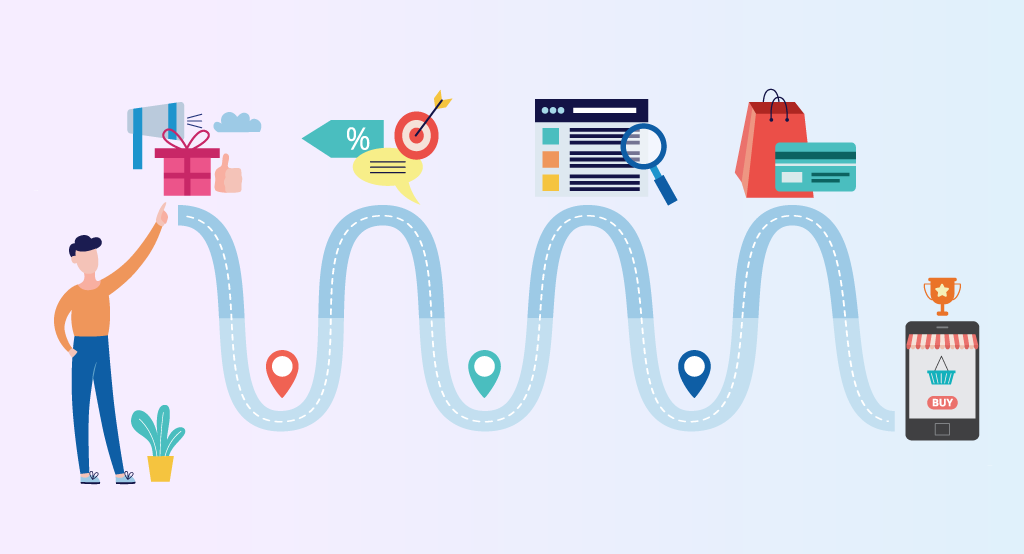There are a few design acronyms you might have come across, such as UX, CX or EX.
Buzzwords become abstract, UX (User Experience) is often confused with graphic design, even within the design industry. If designers are not engaged in the effects digital applications have on people, (via research or testing) then we’re simply doing old fashioned art direction and marketing. So it’s good to try and understand what UX terminology actually means in practice. Experience design considers not only the digital app interface, but how the whole business operates.

Experience design considers the entire customer journey, from purchase to delivery, the common experience we all share when shopping online.
UX design examines our ever-increasing connectedness with technology, how our emotions need to be served well by usable websites and apps. There are different user experience (the ‘X’ bit) contexts, like customer (CX) or employee (EX), both interacting with a computer device, each with a unique viewpoint. An employee needs to do their job efficiently, a customer wants a painless transaction. Both are human beings, and we all need technology to work for us, not against.
UX – User Experience
UX design is primarily concerned with on-screen interactions, how the app functions, but also needs to consider the physical environment in which an app is being used. Our screens are increasingly full to the brim with competing tools and notifications, so UX designers needs to make sure the on-screen controls are easy to operate. We often design for small, mobile phone screens as a priority, working our way up to laptops, then desktop screens, which are still widely used in office environments. We call this process Responsive Design, which uses special Media Query code to modify the screen layout as it changes size or ratio.
Designers want to learn, through research and testing, how people “feel” when interacting with virtual tools on a screen, whether it’s a website or kiosk such as a ticket machine in a busy station.
Designers often refer to users, which de-humanises the process a little. The term user might even confuse experience design with drug use! It’s a clumsy word and very rooted in software engineering. However, it’s quite harmless in the context of research and data analysis. We are not trying to get to know people in a personal sense, as you might with new friends. In product design, we are studying more generalised human behaviour, the common emotions we all share or the shared interests of a specific group of consumers. UX is easy to remember, so User Experience can often refer to the entire process, including CX or EX.
CX – Customer Experience
Customer Experience (CX) considers the entire customer journey. From browsing a digital product page on a website and filling out the checkout form to the products delivery tracking system, confirmation emails and the physical delivery itself. A digital shop assistants are often chatbots, that operates using AI technology. But we still need human support via telephone. Designers cannot lose sight of the all important human aspect of a transaction, while also considering that the experience will never feel totally natural. Online shopping is now more about convenience, but we still like to visit shops, so a digital store must feel connected to the real world.

Customer experience (CX) includes physical world actions, such as quality of delivery, how customer helplines are handled or the design of email notifications.
EX – Employee Experience
The reliability and usability of intranets or workplace software affects productivity and job satisfaction. The Employee Experience (EX) might include checking stock levels, running an intranet, publishing content or analysing data. The positive experience of workplace technology is as important as designing a nice experience for customers. If software is clunky or error-prone then quality of service may drop. Employees will become less productive, when they can’t do their job properly. Businesses will get more complaints due to customer anxiety caused by unreliable technology. Poor service is more likely due to flaws in the design of workplace systems.

Designing a great experience for employees, when using workplace apps or intranets, is crucial for increasing job satisfaction, which helps productivity.
HCI – Human Computer Interaction
It is a daunting task for designers when considering the array of experiences, desires or pain points users face. Or the different contexts in which people are using screen based technology, whether at work or as a consumer. Life is made a whole lot easier when you research the people who will be using the tools. People can often be grouped by community, whether in a virtual or physical space. Customers are usually grouped in a virtual space, perhaps by demographics or common interests. Whereas, employees work together in the same office or factory. But ultimately, using a computer device is a personal experience, it’s a one-to-one with software.
Acronyms, such as UX, CX or EX, are a convenient for designers to partition each area of experience design. But the reality is more blurry. Acronyms are easily thrown around without knowing what they mean, because the design industry is still not fully onboard with human-centered design just yet. Experience design is understanding our relationship with technology. Is it a positive or negative experience when using technology? Human Computer Interaction (HCI) is a very old scientific term from the 1980s. Today, more than ever, real human emotions must be considered when designing technology, whoever you work with or wherever you are located.
How We Define A Digital Product?
For most of my career I have referred to any screen-based interaction as either a website or app. All the tools we use in a web browser are basically HTML documents, many apps on your phone will also have an HTML structure, hosted on an external web server. It’s really confusing for businesses who run an e-commerce store. In their minds they sell physical products on a website (or app). But a design agency or web team, the people who built the system, will refer to the e-commerce store itself as a product. So websites/apps are now effectively digital products in their own right.
As consumers, we still imagine products as physical objects, the things we buy in stores, whether in-person or online.
Consumers will refer to computer games as products, less so the game and more the gaming console itself. But there are more and more things we buy online that have no physicality, including eBooks and digital music. So the word product can mean literally anything you purchase online or off. As designers/developers, it feels more hip to talk about Digital Products, but it’s quite an abstract term. Most people prefer to describe digital experiences by how they function in their lives. Terminology can be unhelpful, because it’s not how people talk. We login to accounts, Google something, go online or stream video. Consumers don’t view websites as products.
The Takeaway
Terminology or acronyms (like UX, HCI etc) in the tech industry is a useful form of communication between design professionals, it’s what we might call talking shop. However, when working with clients, it’s more helpful for designers to speak in clearer, less formal language. It’s less important for a designer to know what the buzzwords are than to understand what the UX design process is trying to achieve. That is, to ensure that computer-based apps are best serving their users.

